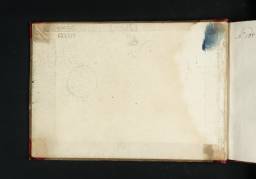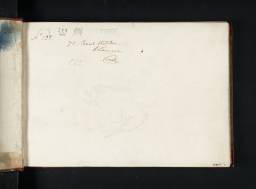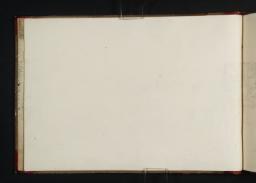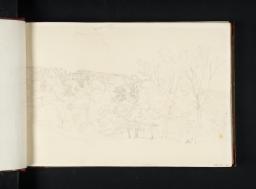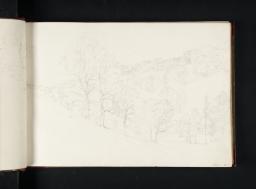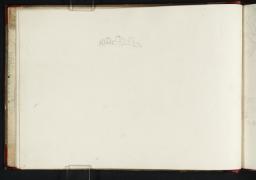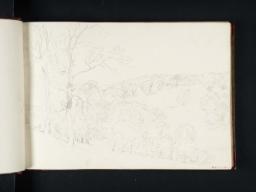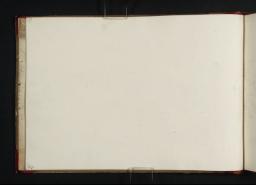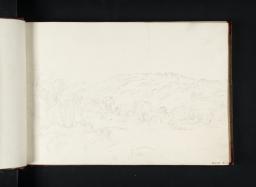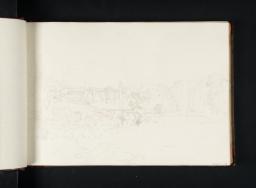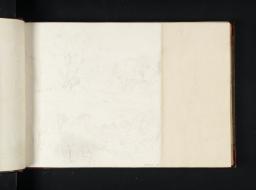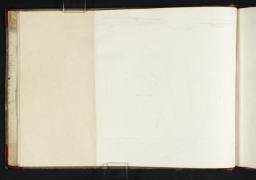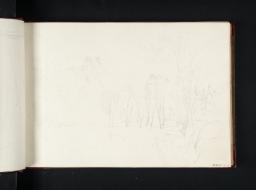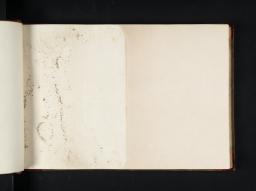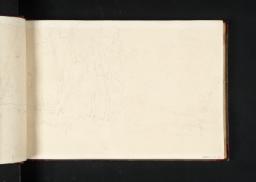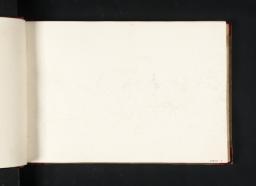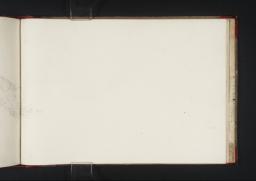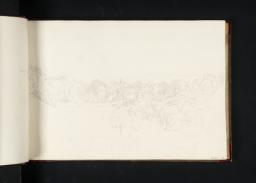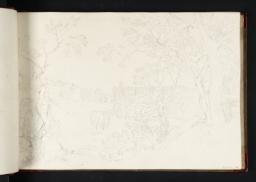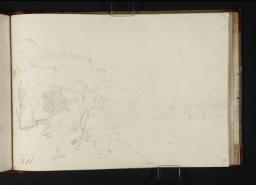Turner Bequest CXXXIV 1–83
Sketchbook bound in boards, covered in grey paper, half-bound with red leather spine and corners, with seven transverse gilt rules to the spine, and pins which formerly secured the fittings of a single clasp filed flush with the covers, the edges of the leaves gilt
83 leaves and paste-downs of white wove paper; various pages watermarked ‘J Whatman | 1811’; page size 179 x 254 mm
Inscribed by Turner in ink on a label on the spine (D40878) ‘112 D[...]shire Yorkshire’, and in ink on the back cover (D40884) ‘Devonshire Rivers 3 | Yorkshire Wharfedale’
Numbered 223 as part of the Turner Schedule in 1854 and endorsed by the Executors of the Turner Bequest, folio 1 recto (D09789)
83 leaves and paste-downs of white wove paper; various pages watermarked ‘J Whatman | 1811’; page size 179 x 254 mm
Inscribed by Turner in ink on a label on the spine (D40878) ‘112 D[...]shire Yorkshire’, and in ink on the back cover (D40884) ‘Devonshire Rivers 3 | Yorkshire Wharfedale’
Numbered 223 as part of the Turner Schedule in 1854 and endorsed by the Executors of the Turner Bequest, folio 1 recto (D09789)
Accepted by the nation as part of the Turner Bequest 1856
Exhibition history
References
This sketchbook comprises roughly equal numbers of West Country and Yorkshire subjects. As discussed in the Technical notes below, it has been rebound (at the British Museum as part of the Turner Bequest restoration programme after the 1928 Tate flood) with the pages in a radically different order from the sequence given by Finberg in the 1909 Inventory, itself ‘more or less arbitrary’.1 Although some views of the same sites were recognised and brought together in this rearrangement, subjects from the two areas remain rather confusingly mingled; presumably Turner did not actually use the sketchbook in this way. Finberg dated it to about 1812–15 in the Inventory,2 and subsequently explained his reasoning: the ‘book ... contains a number of the Devonshire Rivers subjects, it probably belongs to about the time of Turner’s second visit to Devonshire. This visit took place in either 1812 or 1813, and the Wharfedale sketches ... cannot have been later than 1815.’3 Yorkshire writer Herbert Wroot followed on by assigning the sketches of Bolton Abbey (see under folio 7 recto; D09874; Turner Bequest CXXXIV 73) to 1815.4
In terms of the West Country drawings, Eric Shanes noted in 1990 in relation to Turner’s visit to Buckfast Abbey, Devon (see under folio 22 recto; D09844; Turner Bequest CXXXIV 48), that he ‘probably visited the house in 1814, on a third West Country tour we unfortunately know little about.’5 This follows the lead of Sam Smiles and his research on Turner in Devon in the 1810s,6 as set out in the overall Introduction to the present tour; see also the West Country tours of 1811 and 1813 elsewhere in the present catalogue. The Devon and Cornwall views in this sketchbook are here dated to 1814, as it appears to have been used for more detailed studies to complement those in the Devon Rivers, No.1 and Devon Rivers, No.2 books (Tate; Turner Bequest CXXXII, CXXXIII); between them, the three sketchbooks can be demonstrated to comprise a coherent itinerary.
Most of the Devon and Cornwall subjects here also appear in Devon Rivers, No.1, and are noted in the order of the more comprehensive itinerary set out in its Introduction. What may be a north-west Devon estuary is shown on folio 67 recto (D09867; Turner Bequest CXXXIV 66). The identified subjects continue south with Great Torrington (see under folio 30 recto; D09809; Turner Bequest CXXXIV 18), Okehampton (see under folio 59 recto; D09814; Turner Bequest CXXXIV 22), and Lydford (folio 82 verso; D09840; Turner Bequest CXXXIV 45). Turner then made a brief foray into Cornwall to visit Launceston (see under folio 70 recto; D09873; Turner Bequest CXXXIV 72), returning to the Devon border along the River Tamar at nearby Polson Bridge (see under folio 77 recto; D09825; Turner Bequest CXXXIV 33) before making two studies further down the Tamar Valley from the high ground near Calstock Church (see under folio 42 recto; D09836; CXXXIV 41). He then seems to have only employed the book at one more stage on his later route homewards through south-east Devon, around Buckfastleigh and Buckfast Abbey (see under folio 22 recto; D09844; Turner Bequest CXXXIV 48), in conjunction with the Devon Rivers, No.2 book.
The Yorkshire drawings have been associated with Turner’s visits to his friend and major patron Walter Fawkes (1769–1825) at Farnley Hall, in the North Yorkshire Dales near Leeds, on various possible occasions ‘from about 1812’7 (although there had been earlier visits). David Hill, who has catalogued much of the contemporary Yorkshire material elsewhere in the present catalogue, originally thought the particular Yorkshire subjects here dated to about 1814 or 1815,8 but has since come to consider them as a likely coda (discussed below) to the extensive tour of Yorkshire, Lancashire and what is now Cumbria which Turner had undertaken between 17 July and the middle of August 1816,9 starting and ending at Farnley, to gather studies in other sketchbooks for illustrations to Dr Thomas Dunham Whitaker’s projected General History of the County of York (see the Introduction to Hill’s separate section comprising the bulk of the 1816 Yorkshire tour).10
For Hill’s comments concerning the likely 1816 dating of the Yorkshire material in the present book, see the Introduction to the 1816 Yorkshire 1 sketchbook (Tate; Turner Bequest CXLIV) and the entry for Tate D10936 (Turner Bequest CXLIV 37); the Introduction to the Yorkshire 6 sketchbook, possibly also of 1816 (Tate; Turner Bequest CXLIX) and the entries for Tate D11896, D11897, D11900–D11901 and D11908 (Turner Bequest CXLIX 295, 296, 298a, 299, 302a); the Introductions of the Scarborough 1 and Scarborough 2 sketchbooks, which Hill dates cautiously to about 1816–18, albeit tending towards the first year (Tate; Turner Bequest CL, CLI), and the entries for Tate D11940 and D11972 (Turner Bequest CL 21, CLI 18); and the entry for an earlier view of Bolton Abbey (Tate D12117: Turner Bequest CLIV S) among the loose sheets associated with Farnley from about 1808 to 1824; see also Hill’s Introduction to the wider grouping of Turner’s work at and around Farnley between those dates.
Remarking on the Yorkshire sketches in this book, Gerald Wilkinson considered that Turner was ‘at the top of his form in the benign atmosphere of Farnley Hall’.11 1816’s visit was marred by the death of Fawkes’s brother on 16 August after a shooting accident, after which the house party broke up.12 Hill has succinctly outlined Turner’s subsequent movements: ‘When he left Farnley on 20 August, he made a week-long tour of central Yorkshire, and then some time between 27 August and 12 September made a further tour, or possibly separate expeditions, to a number of sites, including Bolton Abbey, Scarborough, Gledhow Hall and Leeds.’13 These are all subjects in the present sketchbook. On the same occasion he noted that Leeds views were made ‘probably at the beginning of September 1816’.14 Hill’s recent exhaustive study of Turner and the Leeds area again dates the sketches made there to 1816.15
For Farnley Hall and associated subjects, see under folio 1 verso (D09790; Turner Bequest CXXXIV 1a), and for nearby Lindley Hall, see under folio 2 recto (D09803; Turner Bequest CXXXIV 13). There are also records of the expeditions of Fawkes’s family and guests on the moors near Farnley (see under folio 32 recto; D09882; Turner Bequest CXXXIV 78), including what appears to have been a favourite spot, the Dovestone outcrop, near Blubberhouses (see under folio 36 recto; D09799; Turner Bequest CXXXIV 10). Figures cross stepping stones, possibly at Burley in Wharfedale, near Farnley, on folio 83 verso (D09888; Turner Bequest CXXXIV 83), and a view of a bridge is possibly another scene on the River Wharfe (folio 68 recto; D09812; Turner Bequest CXXXIV 20). A pencil study of a kingfisher on folio 1 recto (D09789) relates to the Farnley ‘Book of Birds’ to which Turner contributed watercolour illustrations.
In line with Hill’s idea of a ‘tour, or possibly separate expeditions’ in the late summer of 1816, there are views of Bolton Abbey (see under folio 7 Recto; D09874; Turner Bequest CXXXIV 73) and nearby Barden Tower (see under folio 15 verso; D09860; Turner Bequest CXXXIV 59a), on the Wharfe a few miles up-river form Farnley; both sites were already well known to Turner. A new departure was a sketching trip to the centre of Leeds, focusing on Gledhow Hall, a little to its north (see under folio 3 recto; D09805; Turner Bequest CXXXIV 15), and a panoramic conception of the whole town complete with its proliferating industries, seen from the south (see under folio 48 verso; D09883; Turner Bequest CXXXIV 79); the inclusion, albeit on a minute scale within the overall view, of a chapel built between 1815 and 1816, is a fortuitous clue to dating the whole sequence. Both Gledhow Hall and Leeds were the subjects of rapidly completed watercolours, which have been associated with Dr Whitaker’s Loidis and Elmete, a history of the Leeds area published in 1816. While Gledhow was indeed the subject of a supplementary engraving, it seems that the link traditionally made with an 1823 lithograph of the Leeds view may be spurious, as discussed under D09883. (For more on Whitaker and Loidis and Elmete, which included other local views after Turner, see the overall Introduction to the present section.)
Moving further away from Farnley on a north-easterly route leading to the sea, there are views of Fountains Abbey, near Ripon (see under folio 43 recto; D09865; Turner Bequest CXXXIV 64), Rievaulx Abbey (see under folio 24 recto; D09853; Turner Bequest CXXXIV 55), Ayton Castle, near Scarborough (folio 45 recto; D09794; Turner Bequest CXXXIV 5) and Scarborough itself (D09866; Turner Bequest CXXXIV 65). As discussed under the latter, there are similar sketches in other books which may have been made on the same occasion.
On folio 8 verso (D09852; Turner Bequest CXXXIV 54a) is a slight sketch, which may be a recollection of Malham Cove after the more extensive Yorkshire tour earlier in the summer. Other rural studies of woods, hills and valleys without obvious landmarks remain unidentified, even in terms of being West Country or Yorkshire views, partly owing to the much-disrupted page sequence: see folios 17 verso, 37 recto, 39 recto, 53 recto and 56 recto (D09879, D09807, D09800, D09834, D09863; Turner Bequest CXXXIV 76a, 16, 11, 39, 62). The plan of a church on folio 42 verso (D40882), slight diagrams inside the front cover (D40879) and a study of dock leaves on folio 57 recto (D09870; CXXXIV 69) complete the varied contents.
At least one leaf from the book has been identified outside the Turner Bequest (private collection), with a watercolour, heightened with white gouache, of a storm over a rocky coast; stitch holes are evident down the left-hand side, but its original position is undetermined. It was known in the twentieth century as ‘Storm off Margate’,16 having been sold at auction from the collection of John Ruskin in 1869 as ‘Sketch for, or more probably, Commencement of Drawings of the Bass Rock’, and described by Ruskin himself as ‘Most characteristic of Turner’s execution in the middle time, impetuously deliberate.’17 On account of its characteristic wedge-shaped profile, it has most recently been identified as ‘The Mewstone, Devon’.18 Turner had sailed past this prominent rock at the entrance to Plymouth Sound in the summer of 1813, on a well-documented short voyage along the Devon Coast in rough conditions, making several drawings of it in the Plymouth, Hamoaze sketchbook which led to other watercolours and engravings showing stormy scenes; for the sketches and later works see under Tate D09462 (Turner Bequest CXXXI 179a).
As there are no other views of the Mew Stone in the present sketchbook or in the other West Country sketchbooks dated to 1814, the watercolour was perhaps done from memory, perhaps while in Devon that year, or even in 1816 when Turner was using the sketchbook again in Yorkshire. The watercolour’s verso comprises a faint pencil sketch of Barden Tower (for others see under folio 15 verso; D09860; Turner Bequest CXXXIV 59a), together with the following list of familiar Yorkshire subjects:
[...] Rivaulx [sic] [...] | Farnley House | Lindley Hall Pheasant Mr F | Partridge shooting | Woodcock [...] | Moor grouse | Bolton Abbey | Bardon [sic] Tower | Pheasant | Moore [sic] Grouse | Gleadow [sic]’19
These can be related to sketches in the present book, as discussed above; see also the list of Farnley-related subjects inside the back cover (D40883).
See Hill in Hill and Densley 1988, p.60; Hill 1996, pp.38, 202 note 12; and David Hill, Turner and Leeds: Image of Industry, Leeds 2008, pp.38, 202 note 12.
For the fullest account see Hill 1984; see also Hill 2008, p.87, and for more on Fawkes and Farnley see James Hamilton, ‘Fawkes, Walter Ramsden (1769–1825)’ in Evelyn Joll, Martin Butlin and Luke Herrmann (eds.), The Oxford Companion to J.M.W. Turner, Oxford 2001, pp.103–5; see also Hill and others 1980, and Hill and Densley 1988.
Ibid., p.104; Hill and others 1980, p.26, had given this itinerary as ‘presumably’ occurring in the summer of 1815, taking in ‘the Wharfe to Bolton and Barden ... and excursions to Rievaulx Abbey and to Fountains Abbey’ as well as Scarborough.
Andrew Wilton, J.M.W. Turner: His Life and Work, Fribourg 1979, p.389 no.768, reproduced, as ‘Storm off Margate’, ?c.1825.
Ruskin in ‘Catalogue of Pictures, Drawings and Sketches, Chiefly by J.M.W. Turner, R.A., the Property of John Ruskin, Esq.’ Christie, Manson and Woods, London, 15 April 1869, in E.T. Cook and Alexander Wedderburn eds., Library Edition: The Works of John Ruskin: Volume XIII: Turner: The Harbours of England; Catalogues and Notes, London 1904, p.570 no.8; see also Ian Warrell in Warrell (ed.), Franklin Kelly and others, J.M.W. Turner, exhibition catalogue, National Gallery of Art, Washington 2007, fig.25 (colour), as ‘Bass Rock’, c.1822–3.
When offered (but bought in) at Christie’s, London, 4 June 2008 (26, reproduced in colour), it was titled ‘The Bass Rock, Dunbarton – Study’ in the catalogue, but a Christie’s press release of 16 May 2008 re-identified it as ‘The Mew Stone, off Plymouth Harbour’; this was on the advice of Ian Warrell, who had linked the sheet to the present sketchbook, as noted in J.R. Piggott, ‘Salerooms Report’, Turner Society News, no.110, December 2008, p.18, where it was described as ‘The Bass Rock, Dunbarton – Study, later amended to The Mewstone, Plymouth Sound’, c.1814–16 (the Yorkshire drawing and inscription on the verso not being mentioned on this occasion); it was sold at Sotheby’s, London, 3 July 2013 (183, reproduced in colour), with the catalogue entry summarised and the transcription of the verso inscription repeated in J.R. Piggott, ‘Salerooms Report’, Turner Society News, no.120, Autumn 2013, p.32.
Technical notes
How to cite
Matthew Imms, ‘Devonshire Rivers, No.3, and Wharfedale Sketchbook 1814–16’, sketchbook, July 2014, in David Blayney Brown (ed.), J.M.W. Turner: Sketchbooks, Drawings and Watercolours, Tate Research Publication, September 2014, https://www

